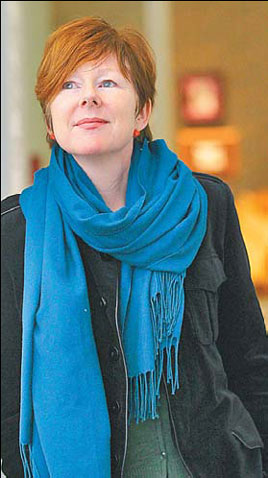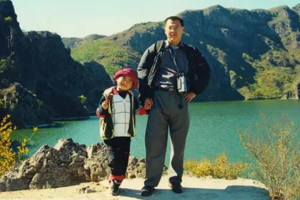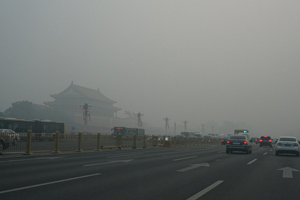A crusader for modern Chinese art
By Chen Nan (China Daily) Updated: 2013-04-09 09:02She has been documenting contemporary art in China for more than 20 years, but this Western advocate of young Chinese artists tells Chen Nan she has so much more to learn.
Karen Smith goes to hundreds of exhibitions in China every year, but she has developed one rule: Never go on opening day.
"There are often many people at the exhibition opening, all talking to the artists and curators. If you really want to see the art, you'd better go after the opening," she says.
However, when the British-born writer-curator first came to Beijing from Hong Kong where she worked in 1992, things were different. It was very quiet in terms of culture in China then. At that time, Smith spent a lot of time going to exhibitions, just as she does now, although the pace was considerably less hectic.
|
 Karen Smith is one of the most important chroniclers of the emergence of Chinese art. Zou Hong / China Daily |
Her first contact with Chinese art was through a traditional medium used in Chinese painting and calligraphy, xuan zhi, mulberry or rice paper, while she was studying fine art at the Wimbledon Art School decades ago.
Before moving to Beijing, Smith worked in Hong Kong as managing editor of art magazine Artention, where she got to know artists from the mainland. The new territory attracted her, which drove her to explore it further.
She started documenting her discoveries of new art emerging from a country she knew little about by taking photographs and notes, and recording her own interpretations of these works.
She learned Mandarin at the Beijing Language and Culture University with the hope that "when my language skills are better, I can go and ask the artists about their works".
Tremendous changes in the contemporary Chinese art scene have taken place since Smith came to Beijing 20 years ago.
As one of the few Westerners chronicling the development of Chinese art over the last two decades, she is still here.
In her new book, As Seen 2, the second book of her As Seen project initiated two years ago, Smith quotes at the beginning: "The ancients would take years to mull over the correct answer to a question. Today we have only minutes to respond". It is a quote from Zhang Xiaogang, one of China's leading artists, written in 1985.
Though he wrote those words almost 30 years ago, Smith believes that this quote is relevant today.
"There is barely time for reflection: There is no time to pause," writes Smith in As Seen 2, which was launched at The Ullens Center for Contemporary Art, a nonprofit art center in Beijing.
Like the first As Seen book, which documented 41 Chinese artists, As Seen 2 records the works of 36 artists and is the sum total of what Smith considered to be the most notable art on show in China in the past year.
In this series, she offers an intimate look at how the artists choose their subjects and the media to express themselves.
UCCA's director Philip Tinari describes Smith's books thus: "In a world where things have changed so quickly and thoroughly, her diaries are probably the most comprehensive firsthand account that remains."
"She is the most important chronicler of the emergence of Chinese art. She has scrupulously attended, processed, recorded and documented the birth and maturation of an entire world," Tinari says.
What has made Smith stay more than 20 years is the constant excitement about art she feels in China. As she puts it, the longer she stayed, the more she realized she did not know.
Smith has seen her share of the unique and unusual.
When artists Lin Tianmiao and Wang Gongxin returned from New York, they had a small exhibition at their home located in the center of Beijing, a courtyard house inside a hutong.
"When you went through the tiny alleyway, suddenly there was amazing art in a simple but beautiful house. It was so exciting," she recalls.
Smith also lives in a courtyard house now, and her home hidden in a hutong near Jingshan Park is like a miniature museum of Chinese contemporary art.
In her interactions with artists, she has made friends with them over discussions and dinners.
"People were not concerned with money. They were concerned with ideas and culture. Everybody felt they were making history. They were creating new work," she says.
Smith's early observations and research also became the basis for her influential book, Nine Lives: The Birth of Avant-Garde in New China, in which she examined the artistic journeys of nine artists, including Wang Guangyi, Fang Lijun and Zhang Xiaogang.
From being a writer and observer, Smith has evolved to being curator and mentor.
"She is a good listener," says Hu Xiaoyuan, a Beijing-based artist who has known Smith since 2003. In January 2013, Hu and another female artist, Duan Jianyu, jointly exhibited A Potent Force, which was curated by Smith.
"She has her own views but never forces an artist to follow. Her clear thoughts about art inspires me," Hu says.
Today, contemporary Chinese art is everywhere, and the young artists, especially, are receiving a lot of attention. Smith points out that it's important to learn how to take a step back.
"People always look for the next new thing. It's like in the fashion world, always looking forward to the next season. But with people, we can't do that. An artist is an artist for life, not just for one season," she says. "It's important to understand how an artist develops and allow them room to develop."
In 2005, she was appointed to the advisory board of OCT Contemporary Art Terminal in Shenzhen, and Smith is also busy with the Xi'an OCT Art Museum, where she serves as the managing director.
It is museums like OCT in Shenzhen and Today Art Museum in Beijing that are developing an important voice, Smith says, together with regional museums like those in Xi'an, Guangdong and Wuhan.
"Progress is slow but the mindset is changing," she says.
- Xi urges stepped-up efforts to eradicate poverty by 2020
- Ministry affirms illegality of home schooling without permission
- China to improve court transparency
- China, Italy pursue innovation
- ID tags issued to troops in PLA units
- 13 PLA units get new personal ID tags
- Boost set for economic, social goals
- Courts told to ignore illegal evidence
- Snow in North China disrupts traffic
- Nobel laureate, Turing Award winner become Chinese citizens, join CAS









